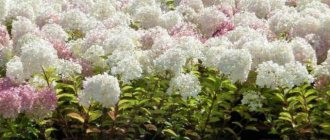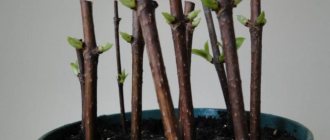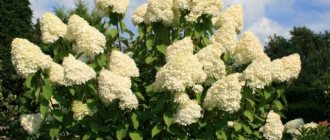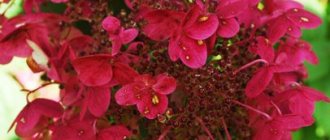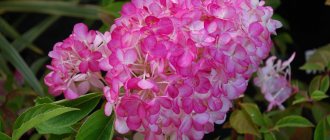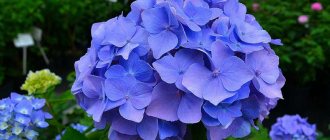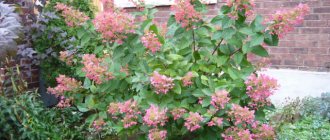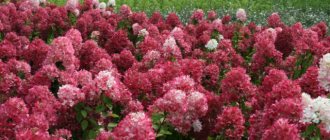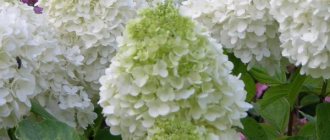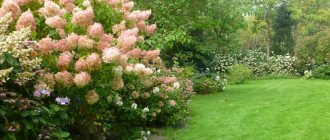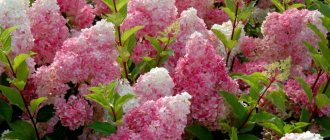Description and photo of Pinky Winky hydrangea
Hydrangea variety "Pinky Winky" is a flowering deciduous shrub.
This plant has a compact size. It rarely reaches a height of 2 m, but it grows very quickly, giving an increase of up to 30 cm per year. The shoots of the plant are very strong, which allows it to maintain a dense and beautiful shape even during flowering. Powerful and elastic branches perfectly withstand the weight of numerous inflorescences. Bushes of this variety do not need support.
The leaves have a dark green color and an elongated oval shape. In autumn they turn red, making the bush even more decorative.
Pinky Winky hydrangea blooms from mid-June to October . It is characterized by abundant flowering; each bush blooms with many cone-shaped inflorescences about 30 cm long. They consist of small flowers, each about 3 cm in size.
After blooming, the flowers are white, but then turn pink, and by autumn they become purple. During the entire flowering period, the shade of the inflorescences changes several times. It looks very beautiful and impressive.
The variety is considered frost-resistant and can withstand prolonged temperature drops down to -25ºС without shelter. And old bushes overwinter even at 30-degree frosts. The older the plant, the higher its winter hardiness.
Application in landscape design
Hydrangea Pinky Winky decorates the garden throughout all four seasons. In spring, bright green shoots appear, followed by buds that turn into white flowers. As the summer progresses, the shades of the petals change, and by autumn the bush is covered in a magnificent purple-pink color. And dry inflorescences look beautiful in a winter landscape against a background of snow. Individually planted hydrangea bushes or planted as hedges can be a good addition to a garden blooming in late summer, when few other shrubs remain in bloom. Grown in large containers, compact bushes can decorate decks, porches and patios.
Florists often use fresh hydrangea flowers to decorate bouquets. But the inflorescences can be dried if the cut cones are hung on a rope. In the future, they are used in winter floral compositions of dried flowers. This hydrangea is easy to maintain as a small tree, i.e. in a standard culture. For this purpose, the central branch is left on the bush, and the rest are pinched 2-3 times during the summer.
Did you know? Hydrangea has its own holiday, which is celebrated on January 5. Although this is not the season for garden flowers, you can make an arrangement from dried inflorescences or purchase a plant in a pot.
At the end of the season, the side branches are cut back entirely to the trunk. At the beginning of the growing season, the central stem is shortened to a developed bud, and when its thickness reaches 1.5–2 cm in diameter, the formation of the crown begins. To do this, all weak and unnecessary branches are cut off, leaving only the strong ones. The stem is strengthened with a metal peg, and the side branches are tied to wire frames, thereby forming the desired crown. For the standard form, you can use bushes that have stopped blooming and graft a fresh scion onto the trunk, giving the bush new life and forming a flowering crown.
Choosing a place for hydrangea
Hydrangea paniculata variety "Pinky Winky" is perfect for landscaping gardens, parks and personal plots. With its bright blooms, it enlivens any landscape and makes it elegant and unique.
In order for this plant to develop well and bloom annually, it is necessary to provide it with certain conditions. This is a rather finicky shrub that will not grow in just any place.
Important for growing Pinky Winky hydrangea is:
- Lighting;
- Soil composition;
- Humidity.
Bushes of the Pinky Winky variety are very demanding on lighting. They do not like strong shading, but also do not tolerate direct sunlight.
The soil for the plant needs light and only acidic or slightly acidic. Even on neutral soils it will develop poorly and refuse to bloom, and on soils with an alkaline reaction, Pinky Winky hydrangea quickly dies.
This plant is moisture-loving. But it does not tolerate either drying out of the soil or waterlogging.
When planting on neutral or alkaline soils, you can use large tubs filled with acidic soil, which are buried in the ground. Shrubs should not be planted in dry places, as well as in particularly wet ones. It is also necessary to provide protection for the plant from the wind using a fence or house wall.
Pest Control
If Pinky is cared for correctly, the flower is not susceptible to infection by various types of pests, but this can still happen. The most common parasite is the leaf aphid, which, with its rapid reproduction, is capable of forming large colonies.
When aphids appear, take the following measures:
- Rinse the entire plant with running water.
- Treat the flower with garlic or soap-tobacco infusion.
- Rinse the potato or tomato tops with a decoction.
- Treat all branches with soda dissolved in water.
- It is also recommended to use special products (for example, spark-bio or actara).
- You can plant some dill, fennel, lavender or marigold nearby. Their aroma repels aphids.
- It is also recommended to grow violets in the neighborhood. These flowers can attract ladybugs, which feed on aphids.
- Slugs and snails must be collected by hand.
If you provide proper care, hydrangea paniculata of the Pinky Winky variety will decorate gardens and flower beds with lush blooms for many years, making the landscape in front of the house more attractive.
Planting a plant
Pinky Winky paniculata bushes are planted in the spring when warm weather arrives. This is usually done in early or mid-May, when the earth is well warmed up. Before disembarking you must:
- Dig a planting hole;
- Prepare soil of optimal composition;
- Prepare the seedling for planting.
The diameter of the planting hole for a seedling of this variety must be at least 60 cm, and the depth - at least 50 cm. These dimensions are due to the fact that the root system of the plant does not go far into the soil, it is superficial. The finished pit is spilled with water, pouring 2-3 buckets of water into it. Next, prepare the soil for planting.
For a bush to grow and bloom, it is not enough to plant it in ordinary garden soil, even if it is acidic. Hydrangea is very sensitive to the composition of the soil. It should be fertile, but light. The best composition for planting Pinky Winky hydrangea:
- Leaf soil;
- Humus;
- Peat;
- Sand;
- Coniferous land.
All components are taken in equal parts and mixed. For each plant, add a handful of superphosphate to the soil.
Seedlings purchased or grown independently must be prepared before planting. Lightly trim the roots so that they are approximately the same length. You can also trim the shoots of the bush into 1-2 buds.
The seedling is placed in the center of the planting hole, and then its roots are covered with prepared soil. The planted bush should be at such a depth that its root collar is at ground level. Then the bush is well watered, and the tree trunk circle is mulched with peat or sawdust.
Caring for Pinky Winky paniculata hydrangea
Panicle hydrangea "Pinky Winky" requires careful care. The most important thing for her is:
- Soil moisture;
- Regular feeding;
- Trimming;
This variety of hydrangea is moisture-loving. For its growth, the soil must always be slightly moist, and drying out leads to the rapid death of the plant. Therefore, attention should be paid to watering the shrubs, especially in the hot summer.
In hot weather, the bushes are watered at least 2 times a week . In spring and autumn, in dry weather, water weekly. In rainy weather, watering is not carried out, as excessive moisture leads to plant disease and death.
Without regular feeding, hydrangea will not bloom annually. The shrub is fed throughout the entire period of growth and flowering.
Fertilizers are applied to the soil at least once a month, but some experts recommend feeding every 2 weeks.
Feeding begins with the appearance of the first leaves in the spring. During this period, they are fed with nitrogen fertilizers to quickly increase leaf mass. Mullein infusion or diluted bird droppings are used as nitrogen fertilizers.
When the first buds form on the bush, you need to move on to fertilizing with potassium and potassium-phosphorus compounds to ensure abundant and long-lasting flowering.
To do this, use superphosphate or specialized compounds for hydrangeas. Pruning is an integral part of caring for Pinky Winky hydrangea .
It is held twice a year. In the spring, before the growing season, formative pruning is carried out, during which the bush is given the desired shape. Remove dry and frost-damaged branches. Shoots growing inside the crown are also cut out. Autumn sanitary pruning is carried out before wintering the plant.
Care
For hydrangeas to be healthy and beautiful, they need care, which consists of the basic rules of cultivation.
Watering and fertilizing
During the first year after planting, regular watering of hydrangeas is required until they take root and become stronger. Once Pinky Winky bushes are established and well developed, they are more drought tolerant than some other hydrangea varieties. When watering, make sure the ground under the mulch and surface soil is deeply moist. It is better to water deeply several times a week rather than in small doses every day.
Important! Do not use fertilizers with a high nitrogen content, as this leads to rapid growth of green mass to the detriment of flowering.
If water does not penetrate into the lower layers of soil, the roots will develop closer to the surface and the plant will not be drought tolerant due to the lack of a deep root system. It should also be taken into account when watering that the roots of hydrangea lie shallow, and the border of their distribution significantly exceeds the diameter of the crown of the bush. On very hot days, hydrangea leaves and flowers may wilt, so watering is necessary.
Otherwise, wilted and underdeveloped inflorescences will not be able to restore their appearance until the end of the season. To fertilize bushes, you can use well-ripened compost or manure, as well as multicomponent mineral compounds, but with a low calcium content. The best way to feed hydrangeas is to apply a slow-release fertilizer for shrubs and trees in early spring, shortly after the bushes are pruned.
You should choose fertilizers that do not contain lime and are specially designed for paniculate hydrangea - Biopon, Compo, Planton H, Agrecol, Lauren. Fertilizing is carried out during the growing season with frequency in accordance with the recommendations of the manufacturers of the selected fertilizers. Feeding is only necessary during plant growth and should be stopped in early August. After this period, hydrangeas enter a dormant phase and begin to form flowering shoots for the next season.
Trimming and shaping
The best time to prune Pinky Winky hydrangeas is early spring, which helps to increase the size of the flowers, shape the crown and makes it possible to sanitize the bush. Larger flower panicles can be achieved by thinning plants to 5–10 primary branches.
This variety blooms on new growth of the current season, so there is no risk of removing potential color. The bushes can be pruned to 60 cm in height, due to which the trunk will thicken at the bottom and the crown will take on a lush shape. Elongated branches are shortened to the first set of buds. In subsequent years, the hydrangea is pruned higher, following the principle of the number of inflorescences left.
Shelter for the winter
Pinky Winky is one of the best and hardiest hydrangea varieties that can easily survive the winter seasons. As soon as the temperature drops, the leaves and inflorescences turn brown. No special winter cover is required, just make sure there is a sufficient (15–20 cm) layer of dry leaf or bark mulch on the soil around the root zone to protect the roots from freezing.
Vegetative dormancy lasts from November to March. Because this variety of hydrangea blooms on new wood, even if it freezes to the ground, new growth will spring up when spring arrives, ensuring the plant's survival.
Only young, fragile bushes need to be covered for the winter with agrotextiles, spruce branches or straw mats. If you purchased container seedlings in the fall, store the hydrangea in a cool place over the winter and keep the soil slightly moist until you can plant the plant in the garden in the spring.
Video: preparing paniculate hydrangea for winter
How to plant?
Hydrangea seedlings of the Pinky Winky variety, which have a closed root system, can be planted in open ground from spring to autumn. Planting of young plants with an open root system is carried out only in the spring. Experienced gardeners say that spring is the most suitable time for planting young Pinky Winky hydrangeas.
Plants planted in the spring take root safely in a new place before the cold weather and endure wintering more easily. Preparation for planting Pinky Winky hydrangeas involves preliminary arrangement of planting holes. The recommended pit depth is 0.5 meters, diameter is 0.6 meters. The distance between the pits must be at least 1.5 meters.
At the next stage, the nutrient soil mixture is prepared to fill the holes. The soil mixture is prepared from leaf humus, peat, and sand. Additionally, it is recommended to add store-bought nutrient soil intended for growing hydrangeas, rhododendrons or azaleas to the soil mixture. Before planting, carefully inspect young plants, slightly shorten long shoots, and remove damaged and dry root fragments. Places of damage and cuts are treated with crushed charcoal.
Then, holding the seedling vertically, place it in a hole, carefully straighten the roots and cover them with nutritious soil mixture. When filling the planting hole, make sure that the root collar of the plant is flush with the ground surface. After filling the hole, carefully compact the nutrient soil mixture with your palms.
The planted bush is watered abundantly, trying not to wash away the soil, after which the tree trunk circle is mulched. Straw, wood shavings or leaf humus are used as mulch. For several days after planting, the hydrangea is watered regularly but moderately, which will speed up the process of its adaptation to new conditions.
Caring for a bush in winter
Hydrangea "Pinky Winky" needs preparation for the winter period. In late autumn, sanitary pruning of bushes is carried out. Remove all faded inflorescences along with 2-3 upper buds. Dry and damaged shoots are also cut out. After this, the soil around the plant is covered with a thick layer of fallen leaves.
The Pinky Winky variety can withstand winter frosts down to -25ºС . But shoots of young plants can be damaged even at -10ºС. Therefore, it is recommended not to plant plants under 3 years of age in open ground, but to grow them in containers and tubs, which can be brought into a warm room for the winter.
Well-rooted in open ground, but still young plants should be covered for the winter. Usually the branches of the bush are bent to the ground and covered with spruce branches or covered with fallen leaves. The top of the plant is covered with film or roofing felt.
Mature Pinky Winky hydrangea bushes need shelter only in places with a harsh climate. If the bush overwinters without shelter, during heavy snowfalls it is necessary to shake off the snow so that the branches of the plant do not break under its weight.
1 Description
Hydrangea paniculata is a very beautiful plant, incredibly popular in garden culture. According to the description, this is a small tree growing up to 5 meters. It tolerates cold well thanks to shoots that quickly become woody. The leaves are pubescent, elliptical in shape. Panicle inflorescences consist of fragrant flowers that are excellent honey plants.
The plant begins to bloom in June and lasts until frost. It can be grown in the central and northern regions of Russia, because it can withstand frosts down to -25 degrees without shelter.
We recommend Hydrangea: planting and care in open ground, popular plant species
1.1 Varieties
Hydrangea paniculata has many varieties, among which the following are distinguished:
| Variety | Description |
| Pinky Winky | It is a compact shrub that can reach a height of two meters. It grows very quickly - up to 30 cm per year. The shoots are very strong, which allows them to maintain a beautiful shape during flowering. Elastic and powerful branches can withstand the weight of a large number of inflorescences well. The leaves are dark green in color and have an oval elongated shape. In autumn they begin to turn red, giving the shrub even greater decorativeness. |
| Grandiflora | A massive plant with velvety oblong leaves and large white inflorescences that turn pink over time. On fertile and well-moistened soils it can grow up to two meters. Frost-resistant, but does not tolerate strong winds |
| Vanilla Fries | Sprawling bush less than two meters high. White flowers form lush inflorescences. Blooms late, loves moisture and light. Tolerates extreme cold well |
| Bobo | A dwarf shrub that grows up to one meter. It blooms with lush inflorescences of light yellow, white and pink shades in the second half of summer. In winter it is mulched with leaves. The bush is often used to decorate small front gardens and flower beds. |
| Phantom | Abundantly flowering shrub. Its large white inflorescences and cream flowers almost completely cover the leaves. For more luxuriant flowering, shoots are pruned short in spring. |
We recommend paniculate hydrangea Phantom: planting and care in open ground
Reproduction methods
Hydrangea seedlings can be bought at garden centers and nurseries, but it’s easy to expand your collection of bushes yourself if you know how to propagate this crop.
Seeds
When ripened, the hydrangea produces a fruit capsule 3 mm long with numerous small seeds inside. Sowing seeds is one of the ways to propagate garden hydrangeas. However, in the case of Pinky Winky, such breeding fails to preserve varietal qualities.
Cuttings
From a practical point of view, propagation by cuttings is easier, it gives results faster, provides almost complete rooting (up to 95%) and is more often successful in amateur growing conditions. The most popular method of propagating most hydrangeas growing in gardens is by cuttings taken in the summer (from June to August) from the apical part of young, not yet flowering shoots. For seedlings, use the tops of sprouts with four leaves and about 15 cm in length - remove the two lower leaves, cut off the upper part of the shoot and cut the remaining leaves in half to reduce the evaporation surface.
Then the ends of the cuttings are treated with a rooting agent (Kornevin) and planted in a ditch or flat container filled with fresh soil for seedlings (special substrate or peat), carefully compacted and watered. Rooted cuttings are transplanted individually into pots , in which they remain until the spring of next year. By this time they produce 3 pairs of new leaves. The tips of the shoots can be pinched to ensure better rooting and development of seedlings.
Important! In central Russia, it is recommended to harvest cuttings from June 10 to 15.
Herbaceous hydrangea cuttings establish quickly, but they usually grow slowly and rarely reach a height of more than 30 cm in the first year. Another way to propagate hydrangeas is through wood cuttings. In early spring, pieces 10–15 cm long are taken from woody shoots and stored in a cool room at a temperature of about +1°C until planting (they should be wrapped in a damp cloth or foil to prevent them from drying out). In late spring, seedlings are planted in a moist substrate and the seedling containers are placed in a warm, bright room, protected from direct sunlight.
By layering
Propagation of hydrangea by layering is another simple method of obtaining new seedlings. In early spring, select a long, flexible shoot from the base of the mother plant and press it gently to the ground. You need to dig a small hole at the point of contact. The branch is placed in the hole, secured with a wooden pin or stone and covered with soil. This place is periodically watered and hilled.
Learn how to make your own hydrangea support.
In the next season, the emerging shoots are dug up and separated from the mother bush. It is recommended to grow a young plant for a year in a fairly large pot so that dense and strong roots are formed. In the future, you can transplant the young hydrangea into open ground into a flower bed where it will grow. If you're lucky, the first inflorescence will appear in the same year.
By division
Sometimes hydrangea can grow into a large shrub that takes up a lot of space in the garden. In this case, you can dig up and divide the plant, obtaining new planting material. Under certain rules, the procedure will definitely be successful. Depending on the size of the root ball, the plant can be divided into 2-3 parts.
Unlike other shrubs, hydrangea has extremely hard roots, so you will have to do this with a saw. It is advisable to carry out the procedure of dividing and replanting during the growing season - in the fall, when the hydrangea sheds its leaves, or in early spring. New bushes will use all their strength to create roots, so a year after dividing they may not bloom.
Description of the variety
The description of the Pinky Winky hydrangea says that this perennial deciduous plant from the Hydrangeaceae family grows in the form of a bush. Due to its winter hardiness, it grows well in central Russia.
For your information! The variety is included in the TOP 10 most popular varieties for landscape design.
All hydrangeas are honey-bearing and have healing properties. Their roots and shoots are used to prevent urolithiasis and treat diseases of the genitourinary system. A decoction of leaves and flowers helps in the treatment of:
- tonsillitis;
- tonsillitis;
- pharyngitis;
- stomatitis.
Hydrangea Pinky Winky
Important! If you are not careful when taking it and in excessive dosages, hydrangea can cause side effects for the body.
Use Cases
Pinky Winky is an ideal solution for landscaping parks, squares, gardens, and personal plots. Flowering shrubs enliven the recreation area, give it unique features, and make the yard cozy. The variety is often used in landscape design as an accent plant. It is suitable for placement near the gazebo to form a hedge. The flower can be planted on the shore of a decorative pond.
The shrub is good in group compositions, especially if it is accompanied by other types of paniculate hydrangea with contrasting colors of inflorescences or herbaceous and decorative leaf crops of smaller sizes, providing a tiered effect in garden ensembles. This way Pinky Winky will stand out among his peers. A good option is to plant ornamental shrubs in splendid isolation. It looks especially advantageous against the backdrop of a green lawn. You will never get tired of admiring it!
How to prepare for landing
Hydrangea rough macrophylla - description, planting and care
For a good future flowering of hydrangea, before planting it, you need to carry out some preparatory measures:
- First you need to select seedlings. You are more likely to purchase a quality plant from a special nursery or garden center. This ensures that the seedling is healthy and belongs to the desired variety. You also need to ensure that the roots are protected from external influences - the plant should be sold in a container.
- Prepare a hole for planting. Its depth and width should be 50*60 cm. It is recommended to water the area well before planting. The distance from hole to hole should be about 1.5 m.
- Prepare the planting mixture. To prepare it you need: peat, humus, rotted leaves, sand. Gardeners can sometimes add flower potting soil for azaleas and fallen pine needles.
- Prepare the plants. Before planting seedlings, they need to be carefully inspected and the roots and shoots lightly trimmed.
Planting process
Hydrangea Dolly - description, planting and care
It is recommended to plant hydrangeas in early spring, as this allows them to take root and gain strength to survive the winter. It is also not prohibited to plant hydrangea bushes in open ground in the autumn.
The planting process is carried out in the following order:
- Place the seedling in the hole and cover it with the prepared planting mixture (the root collar of the plant should remain at ground level).
- Use your hands to compact the soil around it.
- Water the seedling generously.
- Mulch the soil.
- Ensure regular watering of the bushes for the first few days after planting.
3 Planting in open ground
The place for planting in open ground is prepared in advance. The pits are made spacious: 50 cm deep and 60 cm wide. Add soil mixture to them, which consists of the following components:
- rotted leaves;
- humus;
- sand;
- peat.
Many gardeners advise adding coniferous soil or special soil for hydrangeas.
Seedlings are also prepared in advance. To do this, slightly trim the shoots and roots of the plants. Thanks to this, the bush grows lush and neat. If several hydrangeas are planted, the distance between the planting holes should be 1-1.5 m.
All holes are watered abundantly and seedlings are placed in them. Sprinkle with soil and press gently with your hands. In this case, the root collar should be flush with the surface. After planting, the tree trunk circle is well watered and mulched, which helps save the plant from drying out. The following is used as mulch:
- tree bark;
- sawdust;
- peat.
We recommend Description of the paniculata hydrangea variety Phantom, planting and care rules
Hydrangea Pinky Winky - a chic flowerbed decoration
This variety makes you fall in love immediately and forever. It has many advantages and delights throughout the summer with its gorgeous flowering of large inflorescences. The shrub looks delightful when planted alone or in a group with other, lower garden flowers and plants.
What are the features of paniculate hydrangea?
- In European countries, hydrangea appeared in the 18th century, and immediately began to gain popularity. In the 20th century, breeders began to actively work on developing new varieties. Today, about 100 varieties of this beautiful ornamental plant are known. Japan is considered its homeland.
- There are panicle, garden and tree hydrangeas. The first is more cold-resistant, which is more suitable for growing in central Russia with sudden temperature changes and harsh winters. The structure of paniculate hydrangea is different and resembles a small tree rather than a shrub.
- Various varieties come in many excellent colors, and this species is often grown as a greenhouse or houseplant.
- Inflorescences of paniculate hydrangea are in the form of cones or panicles of very large size. The length sometimes reaches 20 - 25 cm. The height of the plant itself, with good care, is more than several meters in adulthood.
- The leaf blades vary depending on the variety: with a smooth surface and slightly pubescent, rounded, oval and with a jagged edge, rough.
- Paniculata hydrangea has medicinal properties and helps get rid of prostatitis, normalizes the functioning of the kidneys and genitourinary system.
Description of the variety Pinky Winky
- Bred in 2003 in Belgium, and since then it has become a favorite in many flower beds and gardens. The main advantage is the huge inflorescences, the length of which often exceeds 20 cm.
- In the inflorescence we find sterile and fertile flowers. The flowering period begins in the second decade of July and continues until the very first frost in October. Moreover, at first the color is milky white, but later gradually changes to pinkish-purple, which adds decorativeness and showiness to the shrub.
- The foliage is a bright green hue in the summer, and in the fall it turns into autumn tones, acquiring a greenish-crimson tone. The upper part of the leaf blade is slightly pubescent, large in size, elliptical in shape.
- When mature, the height of the tree can reach 2 - x m, and the circumference is also at least 2 - 2.5 m. Therefore, when planting, it is necessary to take into account the rather large size of the plant and prepare a spacious area. The annual growth of hydrangea is 25 - 35 cm.
- The structure of the bush is represented by several strong, strong shoots growing upward. Therefore, the shrub does not need gartering or support.
The variety can be grown in different regions of Russia, even in the southern regions of Siberia. But in this case, the shrub needs to be planted in a large tub and brought indoors during cold weather.
Landing rules
Hydrangea paniculata is not the easiest plant to grow, but it is not the most capricious either. If you follow all the basic recommendations, planting and care will not cause much difficulty.
Selecting a location
- Provide for fairly strong growth of the root system, which during growth becomes larger than the diameter of the crown. For this reason, it is advisable to plant Pinky Winky immediately in a permanent place. Transplantation will be quite problematic and will cause long-term stress for the plant.
- If you have little experience in floriculture, then when transplanting an adult specimen, you can damage the root part, which often leads to hydrangea disease. Choose a well-lit place for planting. But light partial shade is also allowed.
- It is better that direct sunlight hits the crown only in the first half of the day, and the rest of the time there is diffused light. This will protect the hydrangea from burns to the leaf blades and overheating of the root system.
- Be sure to choose an area where there will be no drafts or strong gusts of wind.
Soil composition
Hydrangea paniculata loves fertile soil with a high level of acidity (PH 4.5 - 5.5). If you have loamy soil, then add brown peat, sand, sawdust and black soil. The best option is podzolic soils.
The soil should not contain a large percentage of calcium and lime. It is advisable to saturate the soil with organic acids in the required quantity, to make it loose and well permeable to air and moisture. Do not allow a crust to form on the surface. You can add humus to feed it.
If the composition of the soil does not meet the requirements of the shrub, then you may not wait at all for the period of flowering and vigorous growth. The appearance is also not pleasing with green foliage and strong shoots.
Important: Pinky Winky hydrangea, like many other varieties, needs regular feeding with special fertilizers for hydrangeas. There the required amount and composition of the necessary nutrients for successful growth and flowering are calculated.
It is important to constantly loosen the soil, but very carefully so as not to damage the growth of superficial root shoots. Watering is also important.
Important: It is not recommended to add fresh manure to the soil. It is too aggressive for the hydrangea root system. Manure increases soil temperatures and can burn root tissue.
Selection of seedlings
- Before moving on to the planting process, you should purchase a high-quality seedling. Judging by the reviews, young hydrangeas ordered from Belgium are very good (). But you can choose from a nursery in the CIS countries.
- Seedlings in nurseries usually adapt and take root without problems, because they are grown in special plastic containers or bags. For hydrangeas, it is important that the root system is closed and does not dry out.
- If the roots are closed, then the plant can be planted in spring and summer. Young bushes purchased from private owners often have an open root system. Therefore, they need to be planted immediately, but even in this case, hydrangea can hurt for a long time.
Landing
It is best to plant early in the spring, but some gardeners plant hydrangea in the fall. Then you need to do this before the first frost, so that the plant can get used to it and take root. For the winter, seedlings should be carefully covered.
- The depth of the planting hole should not exceed 50 - 60 cm. Dig it in advance so that the soil is structured and settles.
- The top layer of soil must be mixed with humus, peat, sand and coniferous litter (as an alternative, you can use ready-made soil for coniferous species). This composition will maintain the desired acidity of the soil.
- If the soil is poor, add rotted, settled humus after compost and manure. This way you will “start” all the natural processes in the soil, and earthworms will appear. You can add a complex of mineral fertilizers: 65 g of superphosphate, 25 g of urea, 25 g of potassium sulfate.
- Place a mound of fertile soil mixture at the bottom. Place the seedling on top and carefully straighten the root shoots.
- When planting, the root collar should be at the level of the soil surface. After planting, compact the soil slightly so that there are no voids.
- Water the plant generously, and first, before planting, pour water into the hole, let it soak, and then after planting, moisten the soil again and mulch the tree trunk circle.
- This way, moisture will be retained in the required amount in the soil, and weeds will not grow and take away nutrients from the roots.
Diseases and pests and their treatment
If you provide your hydrangea with optimal conditions and careful care, then Pinky Winky will not have serious problems with harmful insects or diseases. But you should know about possible cultivation errors and the most common diseases and pests of this crop, as well as treatment methods. With high humidity, there is some susceptibility of hydrangea to fungal infections, such as kidney disease, bacterial wilt, powdery mildew, leaf spot, rust, gray and root rot.
Spray the affected hydrangeas with the fungicides “Fitosporin”, “Skor”, “Topsin M”, “Topaz”, “Hom”, “Fundazol”. These products can be used alternately with biological products such as Fitoverm and Bisolbifit. Spraying is repeated 2-3 times with an interval of 7-10 days. Hydrangea may also suffer from insect pests such as leaf aphids and spider mites, which feed on the plant's sap, limiting its growth and causing deformation of the leaves and inflorescences.
We advise you to learn how to deal with diseases and pests of paniculate hydrangea.
The bushes should be treated (according to the instructions on the package) with the insecticides “Pirimor”, “Bitoxibacillin”, “Lepidocid”, “Aktellik”, “Provado”. Too much calcium in the soil or too much mineral fertilizer can cause leaf chlorosis. To eliminate this disease, you need to maintain soil acidity (pH 5.5), mulch the bushes with peat or pine bark and water with softer water (preferably rain).
Lack of flowering is often associated with freezing of buds formed on last year's shoots, severe compaction of the crown of the bush, lack of nutrients or insufficient watering and dry soil. If you want a long view of colorful blooms that change color from mid-summer right through to the fall season, the Pinky Winky hydrangea is the one for you. This summer flowering shrub is easy to care for and great for beginning gardeners. And by following the requirements of hydrangeas and proven care procedures, you will avoid mistakes when growing, and Pinky Winky will become a worthy decoration for your garden collection of hydrangeas.
